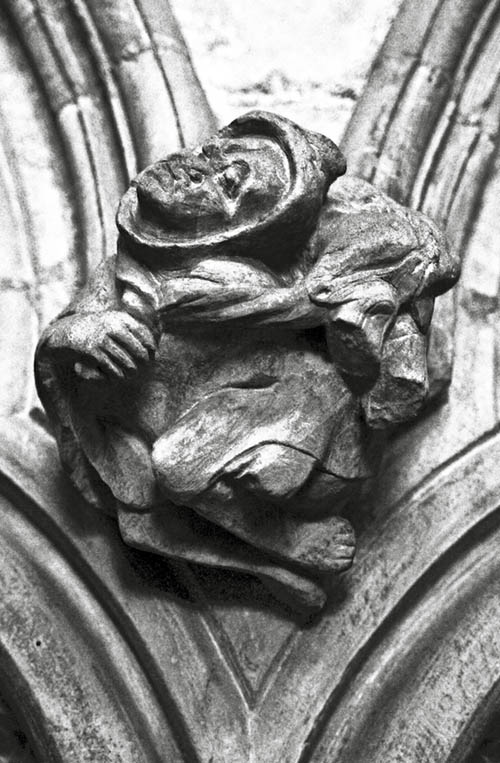Ornamental Forensics
 [Image: Photo by Andy Marshall of Foto Facade from his awesome Flickr set Beverley Minster Hoodmould Carvings].
[Image: Photo by Andy Marshall of Foto Facade from his awesome Flickr set Beverley Minster Hoodmould Carvings].Continuing, briefly, with the ideas presented in the previous post, I wanted to add two more things:
1) Could ancient astronomical events also have been recorded in architectural ornament (not just in paintings or poetry)? In other words, somewhere beneath the overgrown vines of some Indiana Jones-like complex in the Cambodian rain forest—or carved into the solid rock of a minor cathedral near Dijon—is a bas-relief depicting a star gone nova six hundred years ago. This astral disaster left no other record than that. Previously unknown celestial events could thus be pieced together through stone carvings found as far apart as a village church in Russia and a temple on the Deccan Plateau—or even stars in stained glass windows. So is there an architectural equivalent to the appearance of Halley's Comet's in the Bayeux Tapestry? A previously unknown meteor shower historically recorded in a chapel's stone vault?
2) What about epidemiological history as recorded in architectural ornament? Of course, there are already dozens of examples of medical historians determining, through close readings and reinterpretations of literary document, that such and such a king or character must have been suffering from syphilis or a brain tumor or lead-induced dementia. But I'm specifically interested here in how medical symptoms might have taken on ornamental form. Perhaps, in the writhing Gothic forms of church facades—in those old carved faces depicting humans hybridized with angels and demons, plants and animals, minerals and gods—we might yet discover the symptomological clues of some horrifying medieval plague or outbreak. You travel to a remote mountain village in Macedonia to study vernacular church-building traditions only to find a shunned building on the edge of town whose ornamentation borders on the grotesque—and you soon realize that you've discovered not just an architectural masterpiece but evidence of a forgotten disease, similar to Ebola, that had otherwise gone unrecorded. At the very least, this would make for an awesome potboiler or short novel, that I would absolutely love to write (attention, publishers!).
My point, though, is to ask if there are any real-world examples of architectural ornament in which something like an unknown astronomical event, or a disease forgotten by the modern world (weird bodies on a stone frieze in northern India). If so, how might these strange carving be subject to the same type of analysis as explored in the previous post?
I sense a new historical field here—called ornamental forensics—just waiting to happen.





Comments are moderated.
If it's not spam, it will appear here shortly!
Scandinavian Institute of Comparative Vandalism
Always amusing to see architects finding new ways to analyse art whilst neglecting the fact that it was made by artists ie creative human beings with something to say
ornamentalforensics might just be the hottest hashtag for the next 45 minutes though, I guess
fascinating site BTW -congrats
Sorry, I had to reformat a link in a comment from Rebecca Pasternack:
what a great idea...architecture as a record of history that has either been forgotten or was never known in the first place.
when i think of architecture being used to discover a disease not known to the modern world, i think for some reason, of this quirky strange cemetary.
it doesnt have to do with disease in particular but it has to do with death.
This made me think immediately of medieval transis, or cadaver tombs, which emerged in Europe in the mid-14th century. While not literally depicting disease symptoms, these stone carvings certainly seem to illustrate the effect on the human psyche of bubonic plague deaths.
epidemiological history recorded in ornamental form? that't what pest column's across whole europe are
http://images.google.com/images?q=pest%20column&oe=utf-8&rls=org.mozilla:sk:official&client=firefox-a&um=1&ie=UTF-8&sa=N&hl=en&tab=wi
Post a Comment